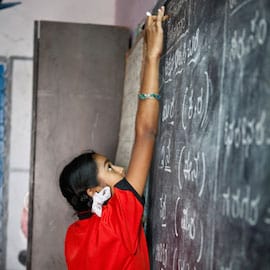Addressing India’s Economic Achilles Heel: Leveraging Trade and Digitalisation to Boost Women’s Labour Force Participation
Most economic outlooks for the near-term — from the International Monetary Fund (IMF) to Morgan Stanley — peg India as a bright spot in an otherwise gloomy economic milieu. The country’s economy is growing, and it is only a matter of time before India surpasses Japan and Germany to become the world’s third-largest economy — one of the early estimates for that to happen is 2027.
With this momentum coming as it takes over the Presidency of the G20, many believe India has a very real opportunity to emerge as the new factory to the world — a position China has held for years. India is already a leader in services exports (often dubbed as the world’s “back office”), and its new wave of digitalisation has allowed it to further consolidate that position, while also facilitating merchandise trade.
Meanwhile, The Economist thinks India’s likely ascent to surpass China as the world’s most-populous country is one of five key stories to watch for in 2023. Some analysts suggest that feat may have already been achieved.
But despite these developments, India’s growing potential will not be fully realised if women’s participation in the economy fails to increase — or worse still, falls.
Addressing India’s Low Female Labour Force Participation Rate
Today, the labour force participation rate (LFPR) for women age 15 and over in India is around 24%. This compares poorly with most countries, no matter which part of the world we look at. For instance, women’s LFPR (15+) is roughly 55% and 57% in the ASEAN region and the United States respectively. This highlights the under-tapped potential for millions of women workers to fill the growing number of factories and offices in India that can produce goods and services for the world.
As production gets deconcentrated and diversified around the world, countries with vastly smaller populations than India’s have much higher female LFPRs: For instance Vietnam — another contender to attract global manufacturing supply chains — benefits from a female LFPR (15+) of 69%, and its consistent success in this area has been lauded by the IMF. India’s Chief Economic Advisor, along with two Indian Economic Service officers, wrote a very well-argued piece on why the country’s female LFPR may not be as low as we think, given methodological issues in measuring women’s participation in the economy. But even if that’s the case, it’s likely that a corrected LFPR would still not demonstrate that the country is taking full advantage of women workers’ potential.
In response to this issue, Prime Minister Narendra Modi has called attention to India’s female LFPR. He has made “women-led development” a priority item in India’s agenda for its G20 Presidency, which aims to be “inclusive, ambitious, action-oriented and decisive.” And last summer, he called for employers to offer more flexible workplaces, to help increase women’s labour force participation. The IMF’s Deputy Managing Director Gita Gopinath has echoed these calls for more labour force participation from women, speaking from the 2023 World Economic Forum in Davos.
However, bringing more women into the workforce — including wage/salary workers, self-employed workers and women-led enterprises — will require interventions at multiple levels, not only economic but also social and political. Below, I’ll discuss two areas where these interventions should focus.
Leveraging International Trade to Increase Women’s Economic Participation
International trade represents a strong avenue for India to advance women’s economic participation. The share of trade in India’s GDP — at 45% as of 2021 — has been growing steadily over the last two decades, aside from periodic dips and reversals that mirror global trends. India has pursued multiple bilateral free trade agreements over the years, which totalled 13 as of April 2022 — and more are currently under negotiation, including with the U.K. and E.U. Since the government has placed a high priority on increasing exports, trade is a key part of boosting women’s participation in the economy, both as workers and entrepreneurs.
Evidence shows that trade creates better jobs for women. Women workers in export-intensive sectors are more likely to be employed formally — they have a 20% probability of being informally employed in sectors with low levels of exports, compared to a 13% probability in those with high levels of exports. Trade’s impact on women can happen through multiple channels: It can lead to better job opportunities, better wages and more enterprise growth. India already has an encouraging base of roughly 15 million women-led micro, small and medium-sized enterprises (MSMEs), over 70% of which are in the manufacturing sector, and many of which are home-based: These women-led enterprises comprise over 20% of all MSMEs in the country. Trade can contribute to women’s economic empowerment not only by increasing the income channel flowing to these MSMEs’ employees upstream or in component supply, but through the creation of new jobs as these enterprises grow.
The servicification of international trade — i.e., the increasing reliance of global merchandise trade on services built into goods/products — also offers new avenues for women producers and traders to benefit. Not only is services trade growing faster than goods trade, but services also account for more than a third of the value added in manufacturing sales and exports. To tap these opportunities, improving women’s access to markets and trade finance is an imperative, to help facilitate and fund MSMEs’ growth into international markets. This can increase women’s participation in global trade, as both producers and employees in value chains and in trade-intensive services like tourism.
To open doors for its women to participate more fully in international trade, India should negotiate trade deals with a gender-lens perspective in mind, recognising that some sectors have high women representation (e.g., textiles, food processing, tourism and hospitality). To take one example, reducing barriers to the service trade can have particularly positive impacts on women, given the high employment of women in services. Some countries already include gender chapters in their trade agreements, to enhance women’s ability to benefit from the opportunities created by such agreements. The World Trade Organization (WTO)’s database on gender equality provisions in trade agreements maps over 300 such provisions across more than 100 agreements globally. Policymakers can review them and identify lessons, if any, for the Indian context. As the Director General of the WTO said in Davos 2023, the “future of trade is services; it’s digital; it’s green, and it should be inclusive.” India has the means to leverage these trends for the benefit of its female workers and entrepreneurs — but to do so, it needs to bring more women into its international trade traffic.
Digitalisation Provides a World of Opportunity to India’s Women
E-commerce has enormous potential to expand markets for women producers and traders. It can often even enable them to surmount social challenges to their economic participation, such as restrictive gender norms or lack of safe transport. This is already happening in many emerging markets, where the involvement of women-owned firms in cross-border e-commerce can be higher than their involvement in traditional, offline trade. For example, Kenyan and Nigerian women-owned firms make up 51% of all businesses in Jumia, a popular pan-African e-commerce platform — a percentage that is higher than women entrepreneurs’ corresponding share of overall businesses in both countries. A similar opportunity exists for women entrepreneurs in India: Cumulative exports by Indian exporters on the Amazon Global Selling programme — just one of many e-commerce platforms operating in India — have surpassed $5 billion. But women enterprises need more support to leverage these platforms, as studies show that the digital readiness of India’s women entrepreneurs is low, particularly in rural areas.
The International Finance Corporation (IFC) estimates that closing the gender gap in e-commerce could generate $300 billion for women entrepreneurs in Southeast Asia and Africa alone. India could experience a similarly dramatic impact, but only if women’s use of e-commerce is given greater attention, potentially under the aegis of the country’s “Districts as Export Hubs” initiative, which was launched by Prime Minister Modi in 2019.
The financing needs of women entrepreneurs is another area where digitalisation can play a constructive role. The IFC recently estimated that women-owned very small businesses in India have a credit demand of $11.4 billion. These gaps need to be plugged, allowing both financial service providers and women entrepreneurs to tap into the underlying opportunities. To that end, fintech offerings can make trade finance and short-term loans available to women, who as a group are known to face much higher barriers than their male counterparts in accessing credit. India’s government is also addressing this need through the PM Mudra Yojana program, which offers collateral-free loans. This provides welcome relief for women entrepreneurs, who often lack assets and therefore face hurdles to credit access. But a comprehensive evaluation of the program’s results from a gender-lens perspective is not available yet.
India’s burgeoning population and its concerted efforts to digitalise have combined with the growing globalisation of manufacturing and services to put the country in a unique position. It is poised to become one of the world’s dominant economies — but it won’t achieve its full potential if its women are left behind. By leveraging the same forces that have fueled its current momentum — international trade and digitalisation — India can empower its women to drive the country’s emergence as a global economic powerhouse.
Abhirup Bhunia is an international development consultant.
Photo courtesy of Sundaramoorthy Thimmarayan, ILO Asia-Pacific.
- Categories
- Finance, Technology



